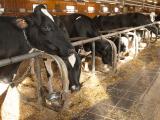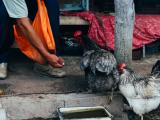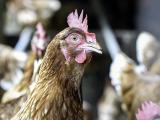Mar 10, 2008 (CIDRAP News) – Animal health officials in India reported that H5N1 avian influenza has resurfaced in West Bengal state, as officials in Vietnam said the virus has struck poultry in another province as well as a farm near Hanoi.
Anisur Rahaman, the state's animal resources development minister, said nearly 1,000 birds have died of the H5N1 virus over the past 10 days in two villages near India's border with Bangladesh, the Associated Press (AP) reported today. Veterinary workers started culling birds in the area after the H5N1 outbreak was confirmed, the report said.
One of the affected districts is Murshidabad, an area that had reported earlier outbreaks, Reuters reported today. Bird deaths were also reported in Birbhum district, where the original outbreak started, the report said.
The new outbreaks were reported less than 2 weeks after the United Nations Food and Agriculture Organization (FAO) praised India for its success in fighting its worst avian influenza outbreak. The initial round of outbreaks began in mid January in the village of Margram. The virus spread quickly, striking poultry in 13 of the state's 19 districts and prompting the culling of almost 4 million birds.
FAO officials had also said that the country was at high risk for more outbreaks and urged India to remain vigilant.
Rahaman told the AP the new outbreaks could have resulted from villagers hiding their poultry during earlier culling operations, or the virus could have been transmitted through the smuggling of birds from Bangladesh, a country that is experiencing widespread H5N1 outbreaks.
Elsewhere, animal health officials in Vietnam said the H5N1 virus struck birds in Quang Tri province in the central part of the country, a local newspaper, Pioneer, reported today, according to Xinhua, China's state news agency. The outbreak killed 90 of 600 unvaccinated ducks at a household, and the remaining birds were culled, the report said.
Vietnam's agriculture ministry said the new outbreaks push the number of provinces reporting recent outbreaks to nine, Xinhua reported. Most are in the northern part of the country.
On Mar 7, veterinary officials reported an H5N1 outbreak at a farm on the outskirts of Hanoi, the nation's capital, Agence France-Presse reported that same day. The virus hit about 2,000 unvaccinated chicken, ducks, and geese, the report said. The remaining birds were culled, and birds in nearby communes were vaccinated.
In other developments, agriculture officials in China today said it has received reports of 12 H5N1 outbreaks this year, Xinhua reported.
Li Jinxiang, director of the ministry's veterinary department, told Xinhua that three of the outbreaks have been confirmed, two in Tibet and one in Guizhou province, all in the southwestern part of the country.
He said unusually cold and snowy conditions contributed to the outbreaks by creating a favorable environment for the virus, hampering regularly scheduled bird vaccination drives, and harming living conditions for livestock.
Jinxiang said government departments across China are launching spring disease control and immunization efforts and that the ministry has gathered 5 billion milliliters of vaccines for immunization activities.



















